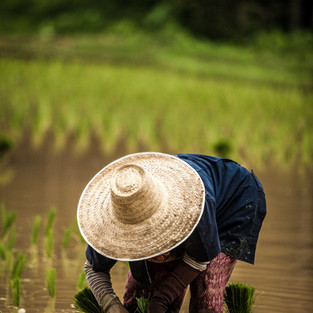What a rice day
- San Living Team

- Jun 9, 2020
- 3 min read
Rice is everywhere, and pretty much eaten anywhere throughout the world with so many variations. Known as the staple food for so many countries and is made in every continent except Antartica; rice is has also been nicknamed the eighth wonder of the world. In Traditional Chinese beliefs, it can increase your yang, provide you with warmth, and nourish your muscles and tissues. While more scientific studies show a strong level of anti-oxidants and vitamin E as well. Not only that but there are also many other health benefits such as:
Health benefits:
-Nourishing for muscles and tissues
-High levels of anti-oxidants, vitamin E
-Stabilizes blood levels and improves blood cholesterol
-Great source of Vitamin B1
-Fibre and source of many other vitamins and minerals
-Reduces risk of type 2 diabetes, stroke and heart disease
-Supports bones as well
-Improves colon health
Being one of the foremost ingredients, rice is considered a staple in many kitchens with many variations being used. Stereotypically, the varieties are sorted by seed size which basically are long, medium or short-grain. These then could be processed differently and have different aromas. Rice's outer layer is called the hull which is removed before eating and you will buy rice without it in most cases while the layer, bran, which is directly after that is sometimes kept. Inside will be the white rice and inside that the "germ" in which all the nutrient is kept. As we said there are three different sizes starting with the long-grain; this rice is usually at least 3 times its width and is fluffy when cooked. Medium-grain rice is shorter and wider, and is more moist and tender, however it tends to stick together. Finally with short-grain rice which is best for sushi while being less than half of its length in width.
There are also different textures with sticky and parboiled rice. Sticky rice as expected comes out much stickier and sometimes sweeter while being commonly used in Asia. Parboiled is a type of converted rice which is steamed before which allows for quicker cooking. The four stereotypical colours of rice are also pretty important starting with polished rice which is the usual white rice you can find anywhere due to its' bran and hull being completely taken off. Brown rice is next due to it usually have the bran still remaining on along with more nutrients but it contains a longer cooking time as result. Black rice is even higher in nutritional value but usually is mixed in due to its nutty and stickier texture. This can usually be found in dishes such as rice pilaf or sticky rice. Finally there is wild rice which is harvested in a very unique type of grass and gives your meals a whole new dimension. It is harder to use though you can find it in soups more commonly.
In the world, arguably the highest quality of rice can be found in Japan due to their specific climate, seasons and more. Despite that there are many varying types of rice that can be found not just there but throughout the world. With over FORTY THOUSAND types of rice, here are some of the more notable types of specialized rice:
Arborio rice: You know it as risotto, while it is a short-grain with mild flavour it usually is cooked in a more creamy base and used in many Italian dishes.
Sticky rice: Another short-grain rice which as aforementioned is used in many Asian cuisines. It can be made in desserts of all sorts and savoury dishes while also being made in to Japanese Sake (alcohol).
Basmati/jasmine rice: Finally a long-grain rice which is extremely aromatic known for being in and from India and Thailand respectively. These rices are wonderfully paired with herbs, and flavourful dishes such as India or Thai Curry.
Wild rice: Completely unlike any other, this is the seed of an aquatic plant which is stereotypically used more as a side or a garnish. It packs more nutrition though!
Wild pecan rice: A long-grain rice that has a flavoured as you expect and hosting a rich aroma.
Sushi rice: A short-grained rice best known for its occasional incorporation of vinegar to increase its ability to stick together. Used in Japanese dishes stereotypically as one would naturally presume.
Overall, if you did not eat rice already; YOU SHOULD TRY. If you do eat rice, you should really try eating new variations and seeing if you can find the difference! With so many possible recipes; we hope to bring you some that you have not tried yet as you join us for this week's adventure at San Living/
















Comments